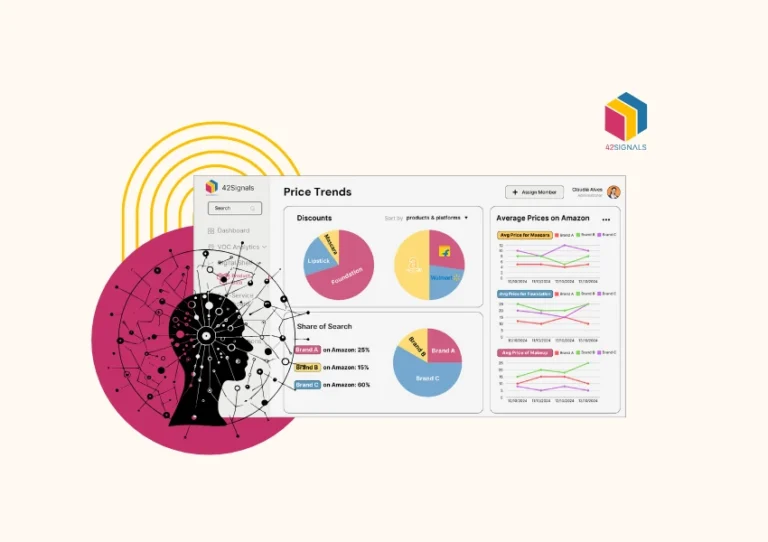Did you know that as of 2024, 85% of global consumers shop online? Due to this growing prominence, acquiring an in-depth understanding of this swiftly evolving retail setting is vital for entrepreneurs seeking enduring triumphs within their industries. Introducing Ecommerce market intelligence – an essential instrument that enables enterprises to efficiently traverse complicated markets, unearth undiscovered opportunities, and boost income streams.
However, lingering questions remain: Why ought it matter to you? Moreover, how can you successfully accumulate and decipher pertinent data embedded within this domain?
Delve further into this discussion to unearth the responses and discover how this function might propel your nascent endeavor toward greater heights.
Understanding Ecommerce Market Intelligence
Essentially, e-commerce market data entails an exhaustive examination of the entire online shopping realm.
From scrutinizing customer profiles and purchase tendencies to evaluating supply chain mechanisms and inventory administration, nothing escapes notice when exploring the rich expanse of insights available.
Stripped down to basics, it essentially enables business owners to respond accurately to three pivotal questions:
- Who am I selling to?
- What should I sell them?
- How can I stand out from my competitors?
It is imperative not to undervalue the significance of addressing these questions, particularly considering the escalating sophistication of present-day ecommerce environments.
Given that worldwide internet connectivity is expanding rapidly, paralleling this development is a surge in shoppers transitioning to web-based marketplaces.
This influx brings both unprecedented opportunity and fierce competition, making accurate market intel indispensable for success.
Data Collection Methods for Ecommerce Market Intelligence

Image Source: Safety Culture
Identifying market trends and opportunities is a crucial aspect of eCommerce market intelligence. To know what to create, businesses need to analyze customer behavior, and product demand, and leverage industry insights. This helps form a better understanding of trends and hone in on untapped opportunities.
One effective method is to conduct market research and gather data on customer preferences, purchasing habits, and demographic insights. This information can be collected through surveys, focus groups, and data analysis tools.
By understanding consumer needs and preferences, businesses can tailor their offerings to meet market demands and address customer desires.
While countless resources exist, they generally fall into one of two categories: primary and secondary sources.
Primary Sources:
These originate directly from firsthand observations, surveys, interviews, or experiments conducted specifically for your project.
Examples include:
- Customer Feedback Forms: Encourage clients to provide honest assessments regarding their experiences interacting with your brand. Such direct input often proves invaluable when tailoring products and services to meet demand.
- Usability Testing: Carefully monitor individuals as they browse your website, identifying problematic sections that could benefit from enhanced User Experience (UX) optimization measures.
- Focus Groups: Bring together a select group of participants hailing from varying walks of life to engage in thoughtful conversations concerning distinct elements of your proposition. More often than not, engaging discourse amongst attendees sheds light on oversights overlooked throughout singular testing engagements.
- Sales Team Interviews: Speak candidly with members of your sales team, extracting pearls of wisdom gleaned from daily interactions with prospective buyers.
Secondary Sources:
Unlike primary sources, secondary ones involve pre-existing materials collated by third parties.
These may encompass academic studies, government databases, trade publications, and commercial analytics providers.
Some noteworthy examples comprise:
- Government Statistics: Access comprehensive datasets detailing economic indicators, employment figures, population growth, etc., providing contextual insights into broader macroeconomic conditions impacting ecommerce sectors.
- Academic Journals & Case Studies: Peruse scholarly articles dissecting theoretical frameworks and empirical evidence supporting various approaches toward successful ecommerce operations.
- Commercial Analytics Providers: Subscribe to specialized platforms aggregating vast quantities of real-time market intel via intuitive interfaces and actionable recommendations.
Effective Data Analysis Techniques
With reams of raw information now at your disposal, it’s time to distill these numbers down into manageable chunks capable of driving tangible results.
Fortunately, numerous analytical techniques facilitate the adoption of this ecommerce market intelligence transformation:

- PESTEL Analysis: Examine the influence of political, economic, sociocultural, technological, environmental, and legal elements on market developments to shape a well-rounded understanding of external impacts.
- SWOT Matrix: Deliberate upon inherent organizational advantages and disadvantages alongside discernible external prospects and hazards, thereby facilitating efficient priority setting.
- BCG Growth-Share Matrix: Sort goods or services based on comparative market presence and industrial growth pace, thus highlighting viable investment targets and shedding light on potential assets slated for reduction.
- Price Elasticity Computations: Determine alterations in customer responsiveness tied to varying prices throughout distinct buyer groupings, thereby formulating advantageous pricing schemes striking a balance between revenues and reasonable costs.
- Customer Lifetime Value (CLV) Projections: Anticipate total income produced by each patron throughout their relationship with the enterprise, consequently aligning resource allocations favoring either procurement or conservation endeavors.
Effective Competitor Analysis Techniques

Image Source: Apirorit
Competitor analysis is one of the most important steps in performing market research. Most successful companies use competitor analysis as a yardstick of their own performance measurement and enhancement strategies as it is effective.
Knowledge of your peers and the strategies they adopt can shine a light on strengths, weaknesses, and opportunities. For new brands, it can mean understanding how to price products; for more established brands it can be a means of research – learning customer pain points and adapting their own product for better delivery.
Paying close attention to product offerings, pricing structures, and customer reviews helps companies position themselves as unique and valuable alternatives. Incorporating social media monitoring tools also helps to get a peek into customer sentiment.
Optimizing Pricing and Promotion Strategies

Image Source: Zapier
Pricing and promotion strategies are key areas where businesses can leverage eCommerce market intelligence to gain a competitive advantage. By understanding market dynamics, consumer preferences, and competitor pricing strategies, businesses can optimize their pricing and promotion approaches for maximum profitability.
One effective strategy is to conduct a price benchmarking analysis, comparing prices of similar products across competitors. This analysis will help businesses determine the optimal price range for their offerings, ensuring competitiveness while maintaining profitability.
Additionally, businesses can leverage data analytics to identify pricing trends and customer willingness to pay. This information can be used to offer personalized pricing incentives, such as dynamic pricing based on customer purchasing history or targeted discounts for specific customer segments.
Brands should also regularly evaluate and optimize their promotion strategies. By monitoring the effectiveness of past campaigns and analyzing customer responses, businesses can fine-tune their promotional activities and maximize their return on investment.
Applying Ecommerce Market Intelligence
Having covered collection and ecommerce analysis methodologies, let’s turn our attention toward implementing resulting insights within actual business scenarios:

- Product Development: Preemptively address latent consumer desires by incorporating cutting-edge technologies, features, and functionalities inspired by market intel.
- Channel Strategy: Diversify distribution networks spanning multiple touchpoints, enhancing visibility and accessibility across varied channels frequented by target audiences.
- Advertising Campaigns: Craft compelling narratives resonating deeply with intended recipients, employing messaging honed through extensive qualitative and quantitative research.
- Promotional Offerings: Maximize return on promotional investments by scheduling discounts, incentives, and giveaways during peak buying seasons identified via seasonality analyses.
- Merchandising Decisions: Curate assortments reflecting prevailing fashion sensibilities, regional tastes, and evolving lifestyle choices deduced from socio-cultural investigations.
Embracing 42Signals
As discussed earlier, tapping into reliable ecommerce analytics software or platforms represents a critical component of any effective ecommerce market intelligence strategy.
That’s where 42Signals shines, specializing in delivering top-notch solutions catering explicitly to burgeoning retailers eager to level up their game.
Our suite of cutting-edge tools streamlines tasks ranging from lead generation to cart abandonment recovery, ensuring no stone remains unturned.
Conclusion on ECommerce Market Intelligence
Navigating the complex waters of contemporary ecommerce necessitates a thorough comprehension of underlying market mechanics.
Armed with robust ecommerce market intelligence capabilities, however, even novice merchants can confidently chart courses toward lucrative horizons.
And remember, whenever you need a helping hand, rest assured knowing that 42Signals is ready to serve as your trustworthy compass guide.
FAQs
What is market intelligence software & tools?
Businesses rely on market intelligence software and tools to collect, analyze, and understand essential information associated with their industry, opponents, and clientele.
Such platforms enable firms to garner vital insights, facilitating well-versed decision-making and fortifying competitive positions.
Harnessing AI and NLP, they pull valuable information from various sources.
Examples of trustworthy providers encompass 42Signals, SimilarWeb, SEMrush, Statista, and Gartner.
What is the global e-commerce market size?
In 2023, the global e-commerce market hit roughly $5.8 trillion following rapid growth attributed to escalated internet usage, modified consumer behavior, and burgeoning technology.
Additionally, the COVID-19 crisis bolstered e-commerce growth substantially.
What is a good source of marketing intelligence?
Reliable marketing intelligence stems from accurate, current, pertinent, and thorough data regarding one’s target market, competitors, and industry trends.
Trustworthy providers consist of 42Signals, SimilarWeb, SEMrush, Statista, and Gartner—each excelling at delivering precise, helpful, and timely information tailored to user demands.
How to do market research for ecommerce?
Effective e-commerce market research requires setting defined goals, pinpointing ideal clients, and inspecting competitors.
Various tools facilitate this procedure, notably those offered by 42Signals. Continuous monitoring ensures alignment with dynamic market circumstances.
What is market intelligence for the ecommerce industry?
Market intelligence refers to the process of gathering and analyzing data and information about the e-commerce industry, including trends, consumer behavior, competitors, and market conditions. It involves monitoring various sources such as social media, online reviews, customer feedback, sales data, and industry reports to gain insights that can help businesses make informed decisions. The goal of market intelligence is to provide a comprehensive understanding of the current state of the e-commerce industry, identify opportunities and challenges, and enable businesses to stay ahead of the competition.
What are the best practices for achieving market intelligence for ecommerce businesses?
- Identify your target audience and their needs.
- Use multiple data sources, including social media, customer feedback, and sales data.
- Leverage technology, such as data analytics software and SEO tracking tools.
- Monitor competitors and industry trends.
- Engage with customers through surveys, focus groups, and social media.
- Analyze data objectively and share insights across teams.
- Continuously gather and analyze data to adapt to changing market conditions.
- Use actionable insights to inform business decisions, such as offering free shipping based on customer preference.





